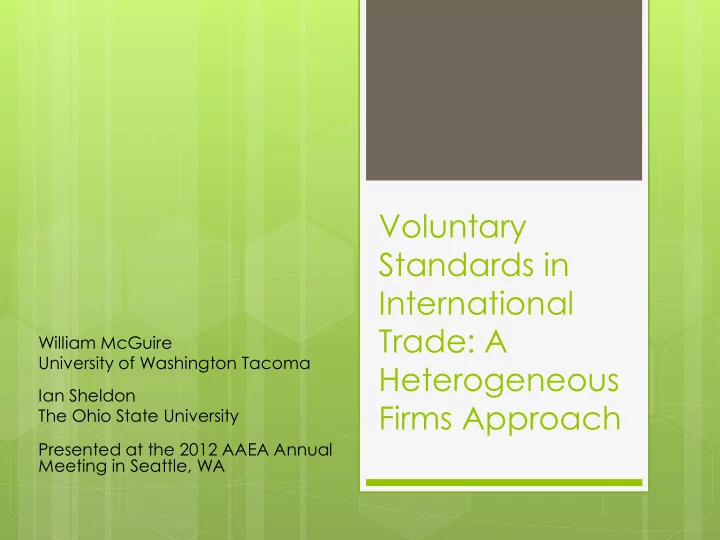

Voluntary Standards in International Trade: A William McGuire University of Washington Tacoma Heterogeneous Ian Sheldon Firms Approach The Ohio State University Presented at the 2012 AAEA Annual Meeting in Seattle, WA
Motivation Widespread concern over negative environmental/labor/safety consequences of trade liberalization WTO does not allow restraint of trade based on process standards Voluntary industry standards (e.g. ISO 9001, ISO 14001, “Fair Trade”) may fill this gap
Objectives Develop formal theoretical framework describing export participation and adoption of voluntary standards Characterize link between liberalization and adoption of voluntary standards
Model Framework Employ heterogeneous firms and trade framework (Podhorsky, 2012; Melitz, 2003) Monopolistically competitive firms choose export and voluntary certification status to maximize profit Differentiated by productivity, indexing effective costs of exporting/certification
Model Framework Firms choose among four possible strategies: No Certification Certification No Exports “LN” “HN” Exports “LE” “HE” “LE” and “HN” cannot coexist in equilibrium
Model Equilibrium 𝜌 HE LE / HN LN 𝜄 𝜄 𝐵 𝜄 𝐶 𝜄
Comparative Statics How do productivity cut-offs change with trade policy parameters? Effect may depend on policy instrument in question Fixed export costs (non-tariff barriers) Transportation costs (tariffs)
Comparative Statics: Fixed Trade Costs LN/LE/HE Case 𝐺 𝐹 𝐼 𝜄 𝐵 𝐼 𝜄 𝐵 ′ % Change from Baseline 𝜄 𝐵 + 20% 𝐼 𝜄 𝐶 𝐼 𝜄 𝐶 ′ 𝜄 𝐶 - 4% TQ - 8% P + 10%
Comparative Statics: Transportation Costs LN/LE/HE Case 𝐺 𝐹 𝐼 𝜄 𝐵 𝐼 𝜄 𝐵 ′ % Change from Baseline 𝜄 𝐵 + 53% 𝐼 𝜄 𝐶 𝐼 𝜄 𝐶 ′ 𝜄 𝐶 + 9% TQ - 3% P + 23%
Conclusions Lowering fixed trade costs always decreases participation in the voluntary standard Driven by competitiveness effect Lowering transportation costs may increase participation in the voluntary standard If revenue effect dominates Raising trade barriers always reduces total quality and consumer welfare
Future Work Relax simplifying assumptions in model Allow for trade between asymmetric countries Allow for export status to affect certification costs and vice-versa Specify external damage function to expand welfare analysis
Thank you!
Recommend
More recommend